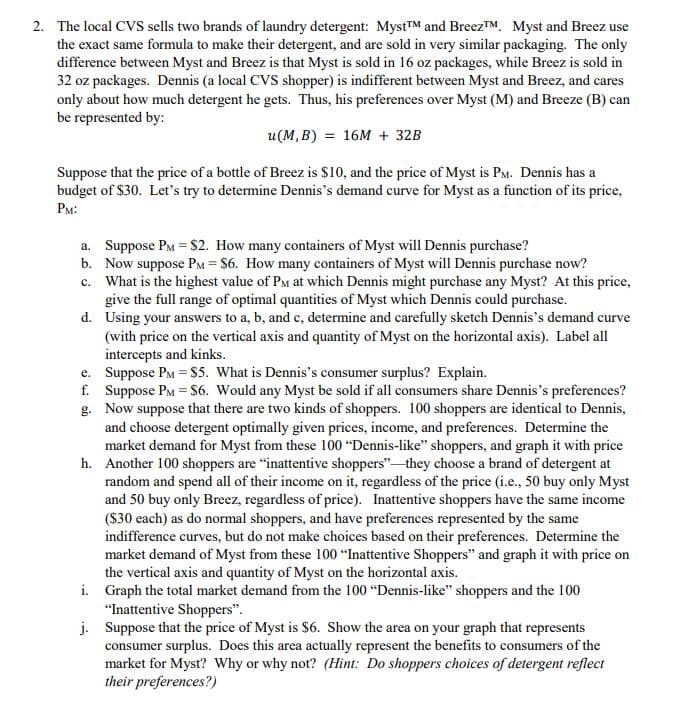The local CVS sells two brands of laundry detergent: MystTM and BreezTM. Myst and Breez use the exact same formula to make their detergent, and are sold in very similar packaging. The only difference between Myst and Breez is that Myst is sold in 16 oz packages, while Breez is sold in 32 oz packages. Dennis (a local CVS shopper) is indifferent between Myst and Breez, and cares only about how much detergent he gets. Thus, his preferences over Myst (M) and Breeze (B) can be represented by: u(M,B) = 16M + 32B Suppose that the price of a bottle of Breez is $10, and the price of Myst is PM. Dennis has a budget of $30. Let's try to determine Dennis's demand curve for Myst as a function of its price, PM: a. Suppose PM = $2. How many containers of Myst will Dennis purchase? b. Now suppose PM = $6. How many containers of Myst will Dennis purchase now? c. What is the highest value of PM at which Dennis might purchase any Myst? At this price, give the full range of optimal quantities of Myst which Dennis could purchase.
The local CVS sells two brands of laundry detergent: MystTM and BreezTM. Myst and Breez use the exact same formula to make their detergent, and are sold in very similar packaging. The only difference between Myst and Breez is that Myst is sold in 16 oz packages, while Breez is sold in 32 oz packages. Dennis (a local CVS shopper) is indifferent between Myst and Breez, and cares only about how much detergent he gets. Thus, his preferences over Myst (M) and Breeze (B) can be represented by: u(M,B) = 16M + 32B Suppose that the price of a bottle of Breez is $10, and the price of Myst is PM. Dennis has a budget of $30. Let's try to determine Dennis's demand curve for Myst as a function of its price, PM: a. Suppose PM = $2. How many containers of Myst will Dennis purchase? b. Now suppose PM = $6. How many containers of Myst will Dennis purchase now? c. What is the highest value of PM at which Dennis might purchase any Myst? At this price, give the full range of optimal quantities of Myst which Dennis could purchase.
Chapter2: Mathematics For Microeconomics
Section: Chapter Questions
Problem 2.15P
Related questions
Question
Please do all of number 2 if possible. If not, just the first few please

Transcribed Image Text:The local CVS sells two brands of laundry detergent: MystTM and BreezTM. Myst and Breez use
the exact same formula to make their detergent, and are sold in very similar packaging. The only
difference between Myst and Breez is that Myst is sold in 16 oz packages, while Breez is sold in
32 oz packages. Dennis (a local CVS shopper) is indifferent between Myst and Breez, and cares
only about how much detergent he gets. Thus, his preferences over Myst (M) and Breeze (B) can
be represented by:
u(M,B) = 16M + 32B
Suppose that the price of a bottle of Breez is $10, and the price of Myst is PM. Dennis has a
budget of $30. Let's try to determine Dennis's demand curve for Myst as a function of its price,
PM:
a. Suppose PM = $2. How many containers of Myst will Dennis purchase?
b. Now suppose PM = $6. How many containers of Myst will Dennis purchase now?
c. What is the highest value of PM at which Dennis might purchase any Myst? At this price,
give the full range of optimal quantities of Myst which Dennis could purchase.
Expert Solution
This question has been solved!
Explore an expertly crafted, step-by-step solution for a thorough understanding of key concepts.
This is a popular solution!
Trending now
This is a popular solution!
Step by step
Solved in 2 steps with 3 images

Knowledge Booster
Learn more about
Need a deep-dive on the concept behind this application? Look no further. Learn more about this topic, economics and related others by exploring similar questions and additional content below.Recommended textbooks for you


Principles of Microeconomics
Economics
ISBN:
9781305156050
Author:
N. Gregory Mankiw
Publisher:
Cengage Learning


Principles of Microeconomics
Economics
ISBN:
9781305156050
Author:
N. Gregory Mankiw
Publisher:
Cengage Learning